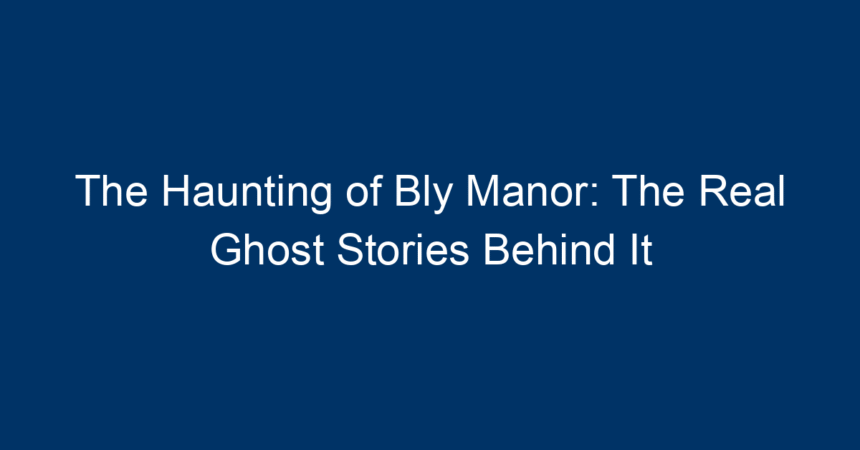Introduction
The Haunting of Bly Manor, a chilling series from Netflix, captivates viewers not just with its narrative but also with the shadows of real-life ghost stories that inspired it. Adapted from Henry James’s novella The Turn of the Screw, this gothic tale intertwines love, loss, and the supernatural. Yet, the spine-tingling atmosphere isn’t merely fiction; it’s rooted in historical accounts of hauntings and spectral appearances. In this article, we will explore the real ghost stories behind The Haunting of Bly Manor, unraveling the fog of mystery that surrounds both the series and the legends that inspired it.
The Background of Bly Manor
Bly Manor itself, a fictional estate at the center of James’s novella, draws from various historical elements typical of gothic architecture and English countryside estates. Built in the 17th century, such manors were often associated with the paranormal, given their long history and depictions in literature as settings of tragedy and melancholy. The Haunting of Bly Manor takes full advantage of this legacy, integrating elements from various ghost stories into its narrative.
The Influence of Henry James’s Works
Henry James’s The Turn of the Screw intricately portrays the psychological and supernatural aspects of hauntings. While the novella portrays two children and their governess at a lonely estate, it also evokes themes of obsession and moral ambiguity. The ambiguity surrounding the ghosts in the story—a characteristic that heavily influenced The Haunting of Bly Manor—leads viewers to question what is real and what is a mere figment of the mind. By analyzing James’s influences, we can discern how The Haunting of Bly Manor blends these elements into its storytelling.
Real Ghost Stories Associated with Bly Manor
The History of English Manors
Many grand English estates have their share of ghost stories. Tales of apparitions, weeping shadows, and unexplained sounds resonate through the halls of these historical homes. For instance, the infamous Borley Rectory, often dubbed the ‘most haunted house in England,’ provides an interesting parallel. Reports of ghostly nuns and strange lights mirror the spiritual dimensions presented in The Haunting of Bly Manor.
The Woman in White
A prevalent specter in British folklore is the Woman in White, a figure often associated with tragic love stories. These tales are echoed in the haunting of Viola, the tragic figure in The Haunting of Bly Manor. Her narrative reflects the universal theme of love that surpasses death, a motif closely related to many real-life ghost stories. This connection helps underline the emotional core of Bly Manor’s haunting, drawing viewers deeper into its emotional landscape.
The Lost Children
Another fascinating aspect of ghost stories tied to Bly Manor’s themes is the recurring trope of lost children. Several historical accounts cite the apparitions of children, often mischief-makers or sorrowful spirits. The children in The Haunting of Bly Manor, Flora and Miles, mirror this tradition, portraying innocence entwined with dark secrets. Their interactions with ghosts enumerate a blend of fear and fascination—a potent mix that pulls audiences into the narrative.
Themes of Grief and Regret
At the heart of The Haunting of Bly Manor lies the profound exploration of grief and regret. Consequently, many real ghost stories focus on these similar themes, suggesting that the dead often linger because of unfinished business or unresolved emotions. This connection highlights Bly Manor as not just a haunted house but a poignant setting where emotional turmoil manifests into supernatural occurrences.
Ghosts as Metaphors
In both the series and real-life ghost tales, apparitions often serve as metaphors for the characters’ inner struggles. For instance, Danny’s encounters with ghosts emphasize her deeper fears and her quest for self-identity. These ghostly manifestations are not mere plot devices; they are profound representations of human vulnerability and the specter of the past that haunts us all.
The Role of Memory in Haunting
Memory occupies a central role in The Haunting of Bly Manor. The spirits represent not just physical presences but also fragmented memories that shape the narrative. In folklore, memories often serve as triggers for hauntings, suggesting that the past cannot simply be buried; it must be acknowledged and reconciled. This mirrors the journey undertaken by the characters in the series as they confront their respective pasts.
The Cinematic Depiction of the Supernatural
The creators of The Haunting of Bly Manor skillfully weave real ghost stories into the fabric of the show. By utilizing atmospheric cinematography and sound design, they evoke an air of dread that makes the supernatural feel tangible. The portrayal of ghosts as emotional entities rather than mere scary figures makes each apparition impactful, providing depth to the overarching narrative.
Creating Mood with Setting
The manor itself, with its grand yet decaying architecture, sets an excellent backdrop for exploring otherworldly themes. The surrounding gardens and detailed interiors evoke a sense of history and loss, mirroring the trapped spirits wandering the estate. This atmospheric creation is crucial in grounding the series within the tradition of ghost stories.
Conclusion: Reflecting on Ghost Stories in Bly Manor
In conclusion, The Haunting of Bly Manor offers a multi-layered exploration of love, loss, and the impact of unresolved emotions. The show’s ties to real ghost stories not only enrich its narrative but also invite viewers to question their own understandings of memory, grief, and the supernatural.
Actionable Insights for Further Exploration
-
Read Henry James’s The Turn of the Screw: To gain a deeper understanding of the source material, reading the original novella opens up discussions about psychological horror.
-
Explore Local Folklore: Investigate ghost stories from your own hometown or country. Personal connections to local lore can make the exploration of ghosts even more engaging.
-
Visit Historic Estates: Engage with history by visiting local historic homes or manors. Many offer tours that recount ghost stories tied to their pasts.
- Reflect on Themes of Loss: Think about how personal memories influence your own life. Consider journaling about experiences of loss or grief, which can lead to cathartic understanding.
By examining these real ghost stories and their influence on The Haunting of Bly Manor, we understand that the line between fiction and reality is often blurred, revealing profound truths about our shared human experiences. The series serves as a reminder: the past never truly haunts us; it lives within us.




